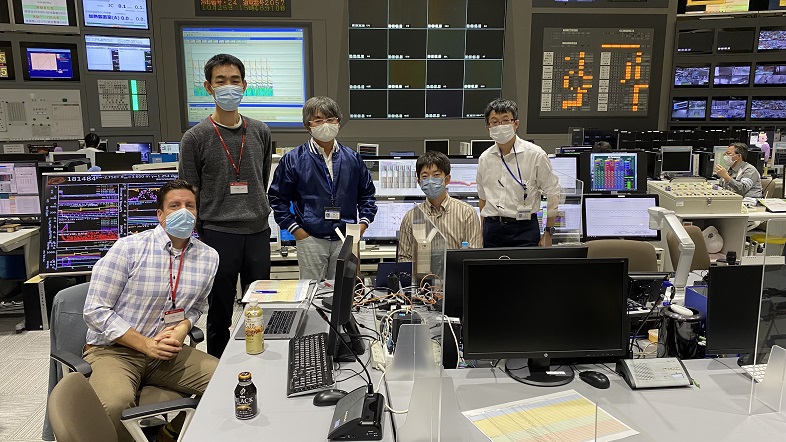1, Mar 2023
First measurements of hydrogen-boron fusion in a magnetically confined fusion plasma

FOOTHILL RANCH, Calif. _ As fusion developers around the world race to commercialize fusion energy, TAE Technologies has pioneered the pursuit of the cleanest and most economical path to providing electricity with hydrogen-boron (also known as p-B11 or p11B), an abundant, environmentally sound fuel. Today the company is announcing, in collaboration with Japan’s National Institute for Fusion Science (NIFS), a noteworthy research advancement: the first-ever hydrogen-boron fusion experiments in a magnetically confined fusion plasma.
In a peer-reviewed paper published by Nature Communications (“First measurements of p11B fusion in a magnetically confined plasma”), scientists explain the outcome of the nuclear fusion reaction of hydrogen-boron in an experiment in NIFS’ Large Helical Device (LHD). This paper describes the experimental work of producing the conditions necessary for hydrogen-boron fusion in the LHD plasma and TAE’s development of a detector to make measurements of the hydrogen-boron reaction products: helium nuclei, known as alpha particles. The finding reflects years of collaborative international scientific fusion research, and represents a milestone in TAE’s mission to develop commercial fusion power with hydrogen-boron, the cleanest, most cost-competitive, and most sustainable fuel cycle for fusion.
“This experiment offers us a wealth of data to work with, and shows that hydrogen-boron has a place in utility-scale fusion power. We know we can solve the physics challenge at hand and deliver a transformational new form of carbon-free energy to the world that relies on this non-radioactive, abundant fuel,” said MichlBinderbauer, CEO of TAE Technologies.
TAE is the world’s leading and largest private commercial fusion energy company, and this result represents an important step toward development of hydrogen-boron fusion. In layperson’s terms, the company is one step closer to the realization of a fusion power plant that will ultimately produce clean electricity, with only helium, also known as three alpha particles, as a byproduct. These three alpha particles are the hallmark of hydrogen-boron fusion energy, and inspired TAE’s founders to name the company Tri Alpha Energy, now TAE Technologies.
Pioneers in Fusion Science
More than 30 groups are now pursuing the development of fusion energy around the world, and approaches vary widely—from style of reactor configuration to the type of fuel the future reactors will rely on. Since TAE’s founding in 1998, the company has built five National Laboratory-scale devices and has successfully generated and confined fusion plasma more than 140,000 times. TAE is currently building and designing two more machines, Copernicus and Da Vinci, which will be able to demonstrate net energy and deliver power to the grid, respectively.
Inventing fusion reactors that produce net energy is one thing, delivering it as a reliable, grid-ready source of electricity is another. By choosing to pursue hydrogen-boron as a fuel cycle, TAE has anticipated the true demands of commercial, daily use of fusion energy. Most fusion efforts around the world are focused on combining hydrogen isotopes deuterium-tritium (D-T) to use as fuel, and the donut-shaped tokamak machines commonly used in fusion concepts are limited to D-T fuel. Unlike those efforts, TAE’s compact linear design uses an advanced accelerator beam-driven field-reversed configuration (FRC) that is versatile, and can accommodate all available fusion fuel cycles, including p-B11, D-T and deuterium-helium-3 (D-He3 or D3He). This benefit will uniquely enable TAE to license its technology on the way to its ultimate goal of connecting the first hydrogen-boron fusion power plant to the grid in the 2030s. With the FRC, TAE is advancing a modular and easy-to-maintain design that will have a compact footprint with the potential to take advantage of a more efficient magnetic confinement methodology, which will get up to 100x more power out, as compared to tokamaks.
As TAE’s colleagues at NIFS note, hydrogen-boron is considered an advanced fusion fuel because it “enable(s) the concept of cleaner fusion reactors. This achievement is a big first step towards the realization of a fusion reactor using advanced fusion fuel.”
As the paper published in Nature Communications puts it: “While the challenges of producing the fusion core are greater for p11B than D-T, the engineering of the reactor will be far simpler. … Stated simply, the p11B path to fusion trades downstream engineering challenges for present day physics challenges. And the physics challenges can be overcome.”
The hydrogen-boron approach is part of TAE’s core vision for commercial fusion energy, born of the company’s technology co-founder Dr. Norman Rostoker’s philosophy of keeping the “end in mind.” This vision for truly clean, abundant, cost-competitive energy is what sets TAE apart from a growing field of fusion companies. While this reaction did not produce net energy, it demonstrates viability of aneutronic fusion and reliance on hydrogen-boron.
TAE expects to demonstrate net energy on its next research reactor, Copernicus, around mid-decade.
Tradition of Scholarship and Collaboration
TAE announced its partnership with NIFS in 2021, teaming up with esteemed scholars at the inter-university research institute located in Toki City, Japan. The three-year joint research project bloomed from a longstanding collaboration between American and Japanese fusion researchers to explore aneutronic fusion.
- 0
- By Rabindra







